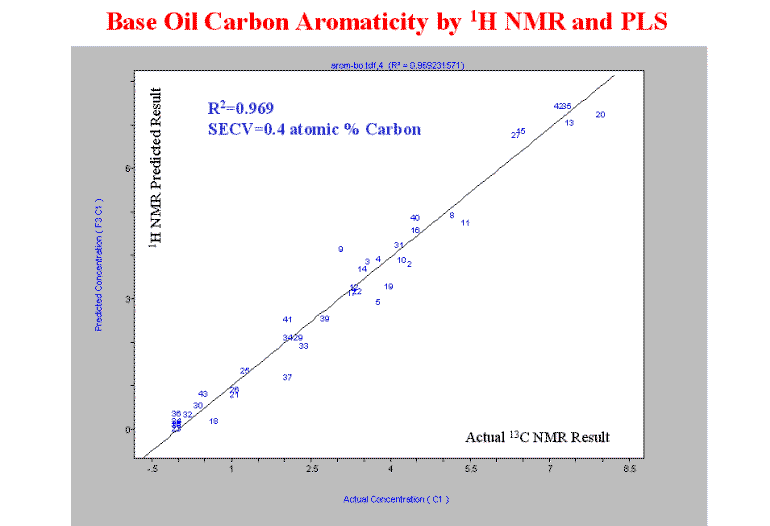Carbon Aromaticity and Related Parameters
For years research has shown that carbon aromaticity is a superior parameter when used to define the aromatic nature of hydrocarbon streams within the refinery. Its use would be extremely useful in characterization of FCC feed-streams, coker feedstreams, reformer/platformer feed, hydro-desulfurization units, etc. In fact, anywhere the process requires knowledge of a hydrogen balance the carbon aromaticity number is invaluable. Unfortunately, the only way to truly determine this value is by liquid-state 13C NMR spectroscopy. This technique has always proved to expensive for the refinery to use on a regular basis. Instead, refiners have turned to easier test methods that equate roughly to the aromaticity – they use refractive index, aniline point, Conradson Carbon, or Ramsbottom Carbon to deduce the aromaticity. Below is a correlation of refractive index to carbon aromaticity obtained by 13C NMR … the correlation is poor!

Recently, PNA has developed another correlative technique that yields far greater accuracy with respect to being able to define a samples carbon aromaticity rapidly through 1H NMR spectroscopy. 13C NMR data is obtained on a 300 MHz NMR spectrometer, the aromaticity is calculated and these values are regressed (using PLS) against 1H NMR spectra obtained on a process NMR instrument. Below are the resulting models obtained on a dataset of base oils and on a dataset of base oils plus a large number of vacuum gas oils (VGO).


These models are currently being improved by addressing signal to noise issues in the original 13C NMR data. All spectra are being acquired with a 10mm NMR probe increasing the signal to noise by an order of magnitude. Standard error of prediction is currently being reduced from about 0.7 atomic%C to 0.3 atomic%C by simply improving the accuracy of the primary method.
From a specialized processing routine it is also possible to determine the carbon paraffinicity and carbon naphthenicity from the same 13C NMR data. These values can also be regressed against the 1H NMR spectra using PLS to yield calibrations that will improve online process control for units processing heavy distillates.
PNA has developed a large database of aromaticity/paraffinicity/naphthenicity for a large range of hydrocarbons from light naphtha to HVGO (heavy vacuum gas oils). This data will be invaluable in defining hydrocarbon chemistry to advanced process control systems and process optimizers. The use of these parameters is being undertaken in several projects such as FCC feed characterization and lube oil manufacturing.


It has been proven in the course of these studies that ASTM D2140 (which correlates aromaticity by an empirical relationship with refractive index and density) does not accurately predict aromaticity and is awful at predicting naphthenicity and paraffinicity. The relationship between D2140 values (CA, CP, and CN) and the actual values calculated from 13C NMR (FA, FP, and FN) are shown below. One can see that a correlation, though poor, does exist between CA and FA. However a poor correlation exists between CP and FP (D2140 consistently too high), and CN and FN (D2140 consistently too low). Correlations are also shown for a small dataset of base oils.



Clearly, when accurate hydrocarbon chemistry is required for process control the NMR derived parameters are far superior to what is available through empirical correlation. No other technique can yield this information.
For more information on this topic please contact us.